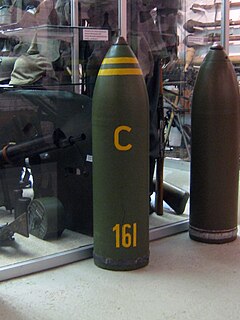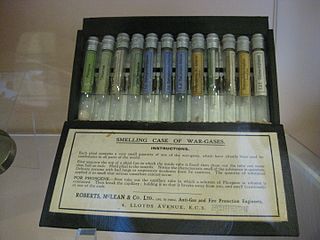 W
WAcrolein is the simplest unsaturated aldehyde. It is a colorless liquid with a piercing, acrid smell. The smell of burnt fat is caused by glycerol in the burning fat breaking down into acrolein. It is produced industrially from propylene and mainly used as a biocide and a building block to other chemical compounds, such as the amino acid methionine.
 W
WChlorine is a chemical element with the symbol Cl and atomic number 17. The second-lightest of the halogens, it appears between fluorine and bromine in the periodic table and its properties are mostly intermediate between them. Chlorine is a yellow-green gas at room temperature. It is an extremely reactive element and a strong oxidising agent: among the elements, it has the highest electron affinity and the third-highest electronegativity on the Pauling scale, behind only oxygen and fluorine.
 W
WDiphenylcyanoarsine, also called Clark 2 by the Germans, was discovered in 1918 by Sturniolo and Bellinzoni and shortly thereafter used like the related Clark 1 gas by the Germans for chemical warfare in the First World War. The substance causes nausea, vomiting and headaches. It can subsequently lead to e.g. pulmonary edema.
 W
WDiphosgene is a chemical compound with the formula ClCO2CCl3. This colorless liquid is a valuable reagent in the synthesis of organic compounds. Diphosgene is related to phosgene and has comparable toxicity, but is more conveniently handled because it is a liquid, whereas phosgene is a gas.
 W
WDisulfur decafluoride (S2F10) is a chemical compound discovered in 1934 by Denbigh and Whytlaw-Gray. Each sulfur atom of the S2F10 molecule is octahedral, and surrounded by five fluorine atoms. S2F10 is highly toxic, with toxicity four times that of phosgene.
 W
WEthenone is the formal name for ketene, an organic compound with formula C2H2O or H2C=C=O. It is the simplest member of the ketene class. It is a tautomer of the even less stable ethynol.
 W
WGreen Cross (Grünkreuz) is a World War I chemical warfare pulmonary agent consisting of chloropicrin, phosgene and/or trichloromethyl chloroformate.
 W
WPerchloromethyl mercaptan is the organosulfur compound with the formula CCl3SCl. It is mainly used as an intermediate for the synthesis of dyes and fungicides (captan, folpet). It is a colorless oil, although commercial samples are yellowish. It is insoluble in water but soluble in organic solvents. It has a foul, unbearable, acrid odor. Perchloromethyl mercaptan is the original name. The systematic name is trichloromethanesulfenyl chloride, because the compound is a sulfenyl chloride, not a mercaptan.
 W
WPhenylcarbylamine chloride is a chemical compound that was used as a chemical warfare agent. It's an oily liquid with an onion-like odor. It is a lung irritant with lachrymatory effects.
 W
WPhosgene is the organic chemical compound with the formula COCl2. It is a colorless gas; in low concentrations, its odor resembles that of freshly cut hay or grass. Phosgene is a valued industrial building block, especially for the production of precursors of polyurethanes and polycarbonate plastics.
 W
WTetrachlorodinitroethane is a chlorinated nitroalkane produced by nitration of tetrachloroethylene with dinitrogen tetroxide or fuming nitric acid. It's a powerful lachrymatory agent and pulmonary agent that is six times more toxic than chloropicrin. Tetrachlorodinitroethane may be used as a fumigant.